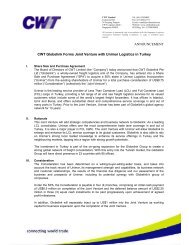notes to the financial statements - Investor Relations
notes to the financial statements - Investor Relations
notes to the financial statements - Investor Relations
Create successful ePaper yourself
Turn your PDF publications into a flip-book with our unique Google optimized e-Paper software.
CWT Limited<br />
70<br />
NOTES TO THE FINANCIAL STATEMENTS<br />
YEAR ENDED 31 DECEMBER 2011<br />
3 SIGNIFICANT ACCOUNTING POLICIES (CONT’D)<br />
3.11 Impairment – non-<strong>financial</strong> assets<br />
The carrying amounts of <strong>the</strong> Group’s non-<strong>financial</strong> assets are reviewed at each reporting date <strong>to</strong> determine whe<strong>the</strong>r <strong>the</strong>re is<br />
any indication of impairment. If any such indication exists, <strong>the</strong> assets’ recoverable amounts are estimated. For goodwill, <strong>the</strong><br />
recoverable amount is estimated at each year at <strong>the</strong> same time.<br />
For <strong>the</strong> purpose of impairment testing, assets that cannot be tested individually are grouped <strong>to</strong>ge<strong>the</strong>r in<strong>to</strong> <strong>the</strong> smallest<br />
group of assets that generates cash inflows from continuing use that are largely independent of <strong>the</strong> cash inflows of o<strong>the</strong>r<br />
assets or groups of assets (<strong>the</strong> “cash-generating unit”). Subject <strong>to</strong> an operating segment ceiling test, for <strong>the</strong> purposes of<br />
goodwill impairment testing, cash-generating units <strong>to</strong> which goodwill has been allocated are aggregated so that <strong>the</strong> level at<br />
which impairment is tested reflects <strong>the</strong> lowest level at which goodwill is moni<strong>to</strong>red for internal reporting purposes. Goodwill<br />
acquired in a business combination is allocated <strong>to</strong> groups of cash-generating units that are expected <strong>to</strong> benefit from <strong>the</strong><br />
synergies of <strong>the</strong> combination. The Group’s corporate assets do not generate separate cash inflows. If <strong>the</strong>re is an indication<br />
that a corporate asset may be impaired, <strong>the</strong>n <strong>the</strong> recoverable amount is determined for <strong>the</strong> cash-generating unit <strong>to</strong> which <strong>the</strong><br />
corporate asset belongs.<br />
The recoverable amount of an asset or cash-generating unit is <strong>the</strong> greater of its value in use and its fair value less costs <strong>to</strong> sell.<br />
In assessing value in use, <strong>the</strong> estimated future cash flows are discounted <strong>to</strong> <strong>the</strong>ir present value using a pre-tax discount rate<br />
that reflects current market assessments of <strong>the</strong> time value of money and <strong>the</strong> risks specific <strong>to</strong> <strong>the</strong> asset or cash-generating<br />
unit.<br />
An impairment loss is recognised if <strong>the</strong> carrying amount of an asset or its cash-generating unit exceeds its estimated<br />
recoverable amount. Impairment losses are recognised in profit or loss. Impairment losses recognised in respect of cashgenerating<br />
units are allocated first <strong>to</strong> reduce <strong>the</strong> carrying amount of any goodwill allocated <strong>to</strong> <strong>the</strong> units and <strong>the</strong>n <strong>to</strong> reduce <strong>the</strong><br />
carrying amount of <strong>the</strong> o<strong>the</strong>r assets in <strong>the</strong> unit (group of units) on a pro-rata basis.<br />
An impairment loss in respect of goodwill is not reversed. In respect of o<strong>the</strong>r assets, impairment losses recognised in<br />
prior periods are assessed at each reporting date for any indications that <strong>the</strong> loss has decreased or no longer exists. An<br />
impairment loss is reversed if <strong>the</strong>re has been a change in <strong>the</strong> estimates used <strong>to</strong> determine <strong>the</strong> recoverable amount. An<br />
impairment loss is reversed only <strong>to</strong> <strong>the</strong> extent that <strong>the</strong> asset’s carrying amount does not exceed <strong>the</strong> carrying amount that<br />
would have been determined, net of depreciation or amortisation, if no impairment loss had been recognised.<br />
3.12 Provisions<br />
A provision is recognised if, as a result of a past event, <strong>the</strong> Group has a present legal or constructive obligation that can be<br />
estimated reliably, and it is probable that an outflow of economic benefits will be required <strong>to</strong> settle <strong>the</strong> obligation. If <strong>the</strong> effect<br />
is material, provisions are determined by discounting <strong>the</strong> expected future cash flows at a pre-tax rate that reflects current<br />
market assessments of <strong>the</strong> time value of money and <strong>the</strong> risks specific <strong>to</strong> <strong>the</strong> liability.<br />
Onerous contracts<br />
A provision for onerous contracts is recognised when <strong>the</strong> expected benefits <strong>to</strong> be derived by <strong>the</strong> Group from a contract are<br />
lower than <strong>the</strong> unavoidable cost of meeting <strong>the</strong> obligations under <strong>the</strong> contract. The provision is measured at <strong>the</strong> present<br />
value of <strong>the</strong> lower of <strong>the</strong> expected cost of terminating <strong>the</strong> contract and <strong>the</strong> expected net cost of continuing with <strong>the</strong> contract.<br />
Before a provision is established, <strong>the</strong> Group recognises any impairment loss on <strong>the</strong> assets associated with that contract.





